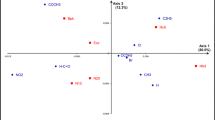Summary
A simple retention model involving adsorption as well as partition effects is applied to non-cyclic alkanes. The dispersion component of surface energies of bonded phase and eluent are measured. Retention is influenced by the activity coefficients of solutes in the bulk and the sorbed eluent phase, the sorption area and the surface energy of the solutes. Sorption area and activity coefficients are correlated to the molecular surface of the solutes. This can be approximated using connectivity functions. The selectivity of a reversed phase system towards alkanes strongly depends on the water content in the eluent. At higher water content the activity coefficients play the dominant role; at very low water content the sorption area values become more important.
Zusammenfassung
Ein einfaches Retentionsmodell, das Adsorptions- und Verteilungseffekte berücksichtigt, wird auf acyclische Alkane angewandt. Die Dispersionskomponenten der Oberflächenenergien von gebundener Phase und Eluens als Systemparameter werden gemessen. Die Retentionswerte sind bestimmt durch Aktivitätskoeffizienten der Soluten im Eluens, das Verhältnis der Aktivitätskoeffizienten der Soluten im sorbierten und im freien Eluens, den Sorptionsflächenbedarf der Soluten und ihre Oberflächenenergien. Die drei erstgenannten Parameter sind mit der molekularen Oberfläche der Soluten korreliert. Sie lassen sich durch Konnektivitätsfunktionen in befriedigendem Maße approximieren. Die Selektivität eines Umkehrphasensystems gegenüber Alkanen wird bei höherem Wassergehalt im Eluens hauptsächlich durch Aktivitätskoeffizienten bestimmt. Bei sehr geringem Wassergehalt gewinnt der Sorptionsflächenbedarf zunehmend an Bedeutung.
Similar content being viewed by others

Literatur
Baker, J. K., Ma, C. Y.: J. Chromatogr. 169, 107 (1979)
Berendsen, G. E., de Galan, L.: J. Chromatogr. 196, 21 (1980)
Bonchew, D., Mekenjan O., Protić, G., Trinajstić, N.: J. Chromatogr. 176, 149 (1979)
Bondi, A.: J. Phys. Chem. 68, 441 (1964)
Colin, H., Guiochon, G.: J. Chromatogr. 158, 183 (1978)
Colin, H., Guichon, G.: J. Chromatogr. Sci. 18, 54 (1980)
Eon, C., Guiochon, G.: J. Colloid Interfaces Sci.45, 521 (1973)
Eon, C.: Anal Chem. 47, 1871 (1975)
Fowkes, F. M.: Chem. and Phys. of Interfaces I, Am. Chem. Soc., Washington, D. C. 1965, 1
Gassiot-Matas, M, Firpo-Pamia, G.: J. Chromatogr. 187, 1 (1980)
Good, R. J., Elbing, E.: Chem. and Phys. of Interfaces II, Am. Chem. Soc., Washington, D. C. 1971, 72
Hermann, R. B.: J. Phys. Chem. 76, 2754 (1972)
Hiller, K. O., Masloch, B., Möckel, H. J.: Fresenius Z. Anal. Chem. 283, 109 (1977).
Horvath, C., Melander, W., Molnar, I.: J. Chromatogr. 125, 129 (1976)
Karen, K., Sebestian, I., Halász, I.: J. Chromatogr. 122, 3 (1976)
Karger, B. L., Gant, J. R., Hartkopf, A., Weiner, P. H.: J. Chromatogr. 128, 65 (1976)
Kier, L. B., Hall, L. H.: Molecular connectivity in chemistry and drug research. New York: Academic Press 1976
Locke, D. C.: J. Chromatogr. Sci. 12, 433 (1974)
Möckel, H. J., Masloch, B.: Fresenius Z. Anal. Chem. 290, 305 (1978)
Möckel, H. J., Freyholdt, T.: in Vorbereitung
Murakami, F.: J. Chromatogr. 178, 393 (1979)
Murray, W. J., Hall, L. H., Kier, L. B.: J. Pharm. Sci. 64, 1978 (1975)
Pierotti, G. J., Deal, C. H., Derr, E. L.: Ind. Engng. Chem. 51, 95 (1959)
Randić, M.: J. Chromatogr. 161, 1 (1978)
Randić, M.: J. Am. Chem. Soc. 97, 6609 (1975)
Scott, R. P. W., Kucera, P.: J. Chromatogr. 142, 213 (1977)
Sinanoglu, O.: Molecular association in biology. New York, Academic Press, 1968
Snyder, L. R.: Principles of adsorption chromatography, Chromatogr. science series, Vol. 3. New York: Marcel Dekker 1968
Valvani, S. C., Yalkowsky, S. H., Amidon, G. L.: J. Phys. Chem. 80, 829 (1976)
Selected values of properties of hydrocarbons and related compounds, API Res. Proj. 44.
Author information
Authors and Affiliations
Rights and permissions
About this article
Cite this article
Möckel, H.J., Freyholdt, T. Retentionsverhalten von Stoffen geringer Polarität an chemisch gebundenen Umkehrphasen und seine Beschreibung durch Konnektivitätsfunktionen. Z. Anal. Chem. 308, 401–412 (1981). https://doi.org/10.1007/BF00466075
Received:
Issue Date:
DOI: https://doi.org/10.1007/BF00466075



